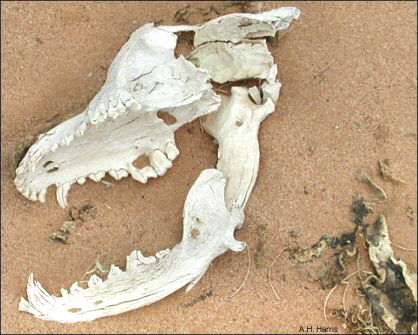

Vertebrate fossils in the Southwest tend to be rare and fragmentary. In fact, it is exceptional for terrestrial animals to become fossilized at all. Think of where we find fossils—almost always where a dead body would have been quickly buried, shielded from scavengers and the weather. And that usually means water-lain sediments. But why should this be so? Wander around in our desert for awhile, and it may become apparent.
Bones lying on the surface are not uncommon, but you'll seldom find
a complete skeleton. Most often, you'll see the bones scattered widely, with some
missing entirely—the sign of scavengers at work. Take a closer look at individual
elements. Those that have been lying around for any length of time are being broken
down by the elements—baked by the sun, soaked by rain, and blasted by wind-borne
sand. Teeth split as their organic matrix dehydrates, and the surfaces of bones crack
and flake. In short order, even by human terms, the remains crumble into the soil,
indistinguishable from minerals that have never lived.

Contributor: Arthur H. Harris, Laboratory for Environmental Biology, Centennial Museum, University of Texas at El Paso.
Desert Diary is a joint production of the Centennial Museum and KTEP National Public Radio at the University of Texas at El Paso.

The skull and jaws of a domestic dog discarded in the desert. Although scraps of
sun-dried hide are still present (lower right), the skull is beginning to crack and
flake, and the teeth have split. Photograph by A. H. Harris. ![]()
Behrensmeyer, A.K., and A.P. Hill, eds. 1980. Fossils in the making: Vertebrate taphonomy and paleoecology. University of Chicago Press, Chicago.